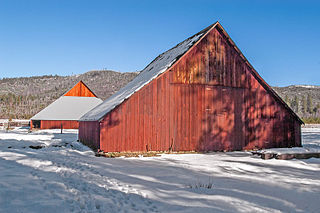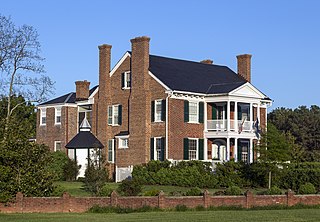
A round barn is a historic barn design that could be octagonal, polygonal, or circular in plan. Though round barns were not as popular as some other barn designs, their unique shape makes them noticeable. The years from 1880 to 1920 represent the height of round barn construction. Round barn construction in the United States can be divided into two overlapping eras. The first, the octagonal era, spanned from 1850 to 1900. The second, the true circular era, spanned from 1889 to 1936. The overlap meant that round barns of both types, polygonal and circular, were built during the latter part of the nineteenth century. Numerous round barns in the United States are listed on the National Register of Historic Places.

The Pete French Round Barn, located near Burns, Oregon, United States, is a round barn listed on the National Register of Historic Places. The late 19th century barn was owned and constructed by cattle rancher Peter French; French trained horses there during the winter. The barn was listed on the National Register on September 10, 1971.

The U.S. National Register of Historic Places (NRHP) classifies its listings by various types of properties. Listed properties generally fall into one of five categories, though there are special considerations for other types of properties which do not fit into these five broad categories or fit into more specialized subcategories. The five general categories for NRHP properties are: building, district, object, site, and structure.

Oxon Cove Park and Oxon Cove Farm is a national historic district that includes a living farm museum operated by the National Park Service, and located at Oxon Hill, Prince George's County, Maryland. It is part of National Capital Parks-East. It was listed on the National Register of Historic Places in 2003.

This is a list of the National Register of Historic Places listings in Olmsted County, Minnesota. It is intended to be a complete list of the properties and districts on the National Register of Historic Places in Olmsted County, Minnesota, United States. The locations of National Register properties and districts for which the latitude and longitude coordinates are included below, may be seen in an online map.

The Belly River Ranger Station Historic District in Glacier National Park includes several historic structures, including the original ranger station, now used as a barn. The rustic log structures were built beginning in 1912. Other buildings include a woodshed, built in 1927 to standard National Park Service plans and a cabin used as a fire cache.

This is a list of the National Register of Historic Places listings in Benton County, Iowa.

This is a list of the National Register of Historic Places listings in Garfield County, Oklahoma.
The James Greer McQuilkin Round Barn is a historic building located near Eagle Center in rural Benton County, Iowa, United States. It was built in 1918 for James Greer McQuilkin. He farmed and sold barns that were designed by Johnston Brothers' Clay Works. The building is a true round barn that measures 60 feet (18 m) in diameter. The barn is constructed of clay tile and features a hay dormer on the north side. The structure does not have a cupola, but has a silo that rises from the center. A new metal roof was added in 1998. It has been listed on the National Register of Historic Places since 1986.

The Erza McKenzie Round Barn is a historic building located near Hazleton in rural Buchanan County, Iowa, United States. It was built in 1922 by Erza McKenzie for a dairy barn. The building is a true round barn that measures 70 feet (21 m) in diameter. The barn is constructed of clay tile and features small cupolas on the west, southwest and south sides of the structure. The building features a two-pitch roof and a central silo. It has been listed on the National Register of Historic Places since 1986.

The McCauley and Meyer Barns in Yosemite National Park are the last barns in the park that retain their original characteristics as structures built by homesteaders. The McCauley barn and the two Meyer barns represent different construction techniques and styles of design.

Cuckoo is a Federal style house in the small community of Cuckoo, Virginia near Mineral, Virginia, built in 1819 for Henry Pendleton. Cuckoo was listed on the National Register of Historic Places on August 19, 1994. The house is prominently sited on U.S. Route 33, which curves around the house. Cuckoo's interior retains Federal detailing alongside Colonial Revival elements from the early 20th century. The house is notable for its design, prominence and its association with the Pendleton family of doctors. The house was named for the Cuckoo Tavern, which stood nearby from 1788. It has been in the Pendleton family since its construction.

The Andrew B. VanHuys Round Barn is a round barn near Lebanon, Indiana, United States. Built in 1912, it was listed on the National Register of Historic Places in 1993.

McWhorter House was a historic home located near Odessa, New Castle County, Delaware. It was built before 1810, and consisted of a two-story, three bay, frame main block with Italianate detailing with a two-story, frame kitchen wing to the rear. Also on the property were an early 20th-century frame privy, a late 19th-century board-and-batten storage shed, hewn frame carriage barn with cross-gable over the entry, a 2+1⁄2-story timber framed crib barn and granary, and an early 19th-century dairy barn.
John McGreer Barn and Crib are a historic building (barn) and structure located in rural Harrison Township, Lee County, Iowa, United States. They are located on a farm northwest of the town of Donnellson. The agricultural buildings were listed on the National Register of Historic Places in 2001.

The Daniel McConn Barn is a historic agricultural building located in near Fort Madison, Iowa, United States. It was listed on the National Register of Historic Places in 2000. It is a bank barn that is built into a south-facing slope. The south exposure of the basement level of the structure allowed protection of livestock in cold weather. The Pennsylvania-type barn was built around 1857 on a farm owned by Daniel McConn, a native of County Down, Ireland. He made his way to Fort Madison in 1837 where he became a merchant. While he owned the farm, it was worked by a tenant farmer. The foundation of the structure is of rubble construction and the sides of the upper structure are of vertical board-and-batten siding. It is capped with a low-pitched, gable roof that features three pyramid-shaped hip roofed ventilation cupolas located along the ridge.

The Burlington Traction Company is a historic trolley maintenance facility at Riverside Avenue and North Winooski Avenue in Burlington, Vermont. The property includes two brick trolley barns, built c. 1900 and c. 1910 respectively, that were used as public transit maintenance facilities until 1999, after which they were adaptively repurposed to other residential and commercial uses. The property was listed on the National Register of Historic Places in 2004.

The McNeil Homestead is a historic ferry-related property off Wings Point Road in Charlotte, Vermont, USA. The complex includes a 19th-century house, former tavern, and barn, all built by members of the McNeil family, the first operators of the Charlotte-Essex Ferry, whose eastern terminus is just south of the property. It was listed on the National Register of Historic Places in 1982.

Mulcahy Barn is a historic building located south of Colo, Iowa, United States. It is a hybrid of German and English immigrant barns, and it is considered an excellent example of a bank barn. The German influence was the placement of the livestock on the lower level, while the simple lines of the upper level reflect the British/colonial influence. The Mulcahy's, who built the barn, were more than likely familiar with the latter. They learned the former after their arrival in Iowa, which had a large German and Scandinavian population by the time they arrived. It was completed around 1885 with board and batten siding on the upper portion and a fieldstone foundation. That foundation was replaced in the mid-20th century with concrete, and again with concrete in 2000. The barn was listed on the National Register of Historic Places in 2004.

The James McCollister Farmstead, also known as the Old Charlie Showers Place, is a historic farmstead located in Iowa City, Iowa, United States. This property was first settled in 1840 by Philip Clark. He laid a claim on the land in 1836, but it was not available until after the Second Black Hawk Purchase of land from the Sauk, Meskwaki (Fox), and Ho-Chunk (Winnebago) tribes in 1837. The claim was secured by The Claim Association of Johnson County until the land was put up for sale in 1840. This was the first farm listed in Johnson County. Clark sold the farm to James McCollister in 1863, and he expanded it to 750 acres (300 ha). He also built the house and the barn, which are the subjects of the historical designation. The farm was owned by his descendants until 1974.



















